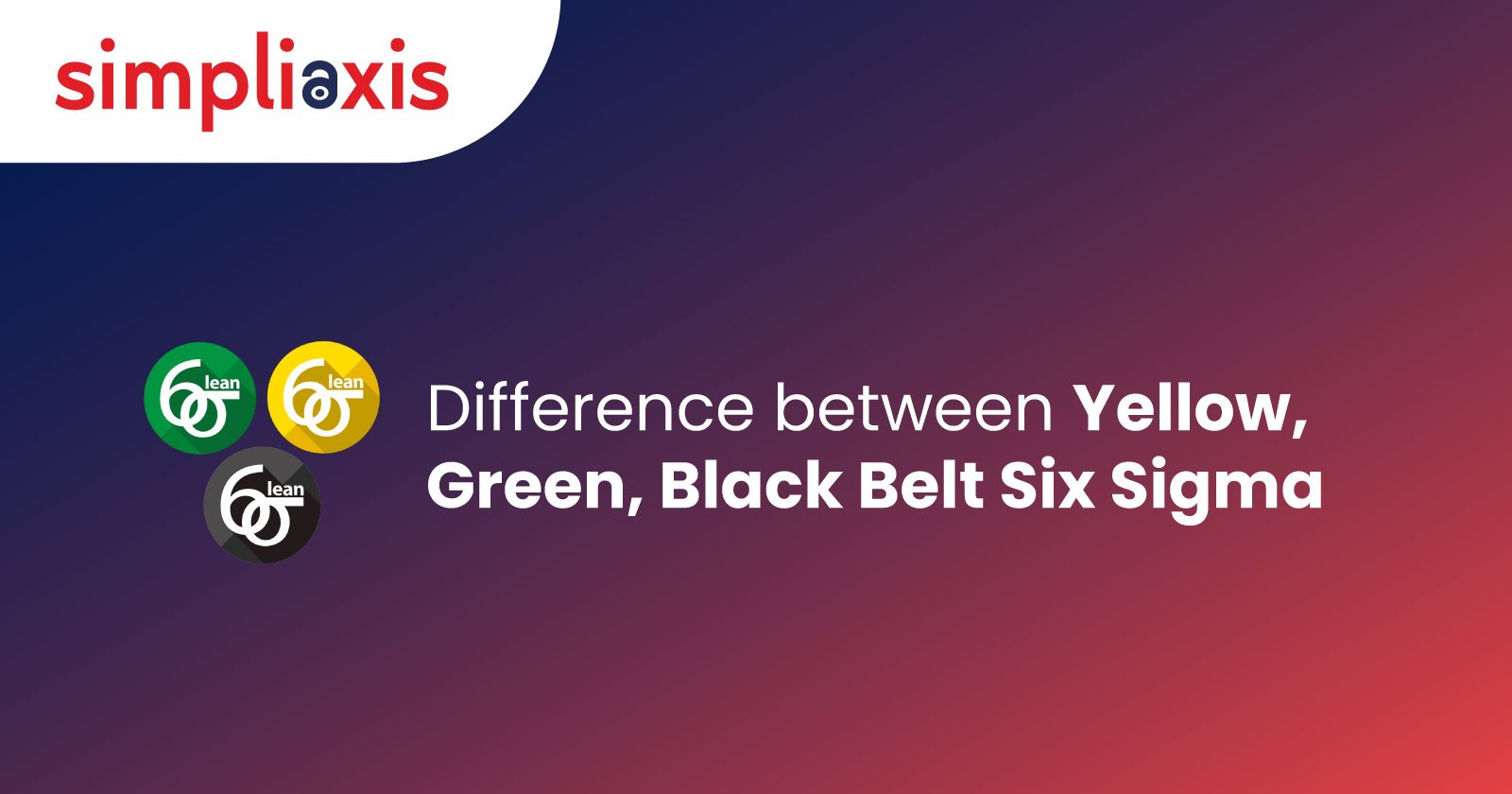Introduction :-
Six Sigma is a data-driven system that offers proven techniques and tools for helping organizations simplify their operations. By simplifying their operations, businesses will be able to provide customers with the highest-quality services and products.
The fundamental focus of Six Sigma is eliminating variation and defects in organizational processes. Training and certification are crucial for successfully implementingSix Sigma practices. Six Sigma, a data-driven system, provides effective tools for streamlining organizational operations, leading to superior customer services and products. Its core aim is to eradicate process variation and defects. Training and certification are essential for successfulSix Sigma implementation, ensuring optimal results.
Understand the Color Codes in Six Sigma
Six Sigma is a complex methodology. So, training is offered at different levels. Each level is specified and denoted by a particular color belt. From white to yellow belts, the belts range in ascending order. From the basic level training at the White Belt Level to the Master Black Belt level, which is the highest level of training, there are other levels in the middle as well. The belts provide learners with increasingly higher expertise and knowledge in Six Sigma techniques and strategies. The picture below will help you gain a better knowledge of the levels:
Six Sigma Belt Levels: An Overview
Before you delve into details about the differences between Yellow, Green, and Black Belt Six Sigma, it is better to gain a fundamental understanding of what these belts mean:
White Belt: This is the basic level of a beginner’s belt. When you acquire the basic working knowledge of Six Sigma practices, you will get the white belt certification. This course also teaches you how these methodologies impact a business.
Yellow Belt: After completing the white level certification, you can take up the education that will get you Yellow belt certification if you wish to gain further knowledge. You will learn more about Six Sigma principles when you reach this level. You will learn how to create process maps and gather data in a project setting at this level.
Green Belt: The third level in Six Sigma Certification in Green Belt in Six Sigma. As a Green Belt holder, you will already be an expert in the concepts and tools of Six Sigma.
Black Belt: On completing training for a Black Belt certification, you will have a mastery of the Six Sigma Tools. Further, you will master data analysis and Six Sigma techniques. With this certification, you can prove to an employer that you are capable enough of leading project teams. When passing a multiple-choice test is enough for Green belt Certification, you must both get through an exam and complete a project to gain a Black Belt in Six Sigma practices.
Master Black Belt:This is the highest level of Six Sigma Master. When you are a Master Black Belt, you will often mentor Black Belt holders and you will even start influencing projects at the enterprise level and not a single project. However, to get this certification, you should have at least five years of experience working as a Black Belt or Master Black Belt. Otherwise, you should have completed a minimum of 10 Six Sigma Black Belt projects. Also, to get this certification, you should go through an examination.
Now, you have a basic idea of different belts in Six Sigma Certification. But you are here to know the Six Sigma Yellow, Green, and Black Belt differences. You can gain a better understanding of the differences from the table below:
Read more: Lean Six Sigma Certification Levels
| Point of Difference | Lean Six Sigma Black Belt | Lean Six Sigma Green belt | Lean Six Sigma Yellow belt |
| Who are they? | Black Belts are leaders and executors of Lean Six Sigma Projects. They use advanced statistics and the best Six Sigma tools and techniques to execute projects. | Lean Green belts are a level below Black Belts. They function with the help of fundamental statistics and soft skills when it comes to project execution. They work on the basis of instructions from either Black Belts or Master Black Belts. | Yellow belt holders are regarded as prime candidates to participate in Lean Six Sigma Teams in an organization. They are certified and trained with general knowledge of the Lean Six Sigma approach and fundamental tools and methodologies. |
| Key Role | The key role of Six Sigma Black Belts is to ensure overall process success. They mentor Green belts using the right Six Sigma techniques and tools. | The key role of a Green belt holder is to carry out the responsibilities assigned by a Black Belt or master Black Belt. Further, they are responsible for preparing the team leader to address the initial chances for improvement | Yellow belt holders are responsible for providing meaningful assistance through dedicated projects. They contribute to achieving their organization's performance goals. |
| What Will They Learn? | The training for Black Belts will provide trainees with a fundamental overview of improvement and quality. They will also learn the DMAIC project approach and how to approach the lean Six Sigma methodology. They will get an overview of different phases, such as control, improve, analyze, measure, and define. | They will learn how to apply DMAIC Methodology and root cause analysis techniques. They will also learn how to work with a Black Belt in a Six Sigma improvement team. Most importantly, they will understand how to improve customer satisfaction. Further, the training will teach them how to apply the tools to improve the functional area. | Yellow belt training will teach the basics of quality and Six Sigma concepts and philosophy. They will learn fundamental lean concepts and philosophy. Even, they will learn the lean approach basically. |
Now, you know the difference between Lean Six Sigma Yellow, Green, and Black Belts. The difference lies not only in the way training is provided and concepts covered but also in the responsibilities they take on in organizations.
In addition to Black, Green, and Yellow belt training and roles, Lean Six Sigma also encompasses other roles. They are the Lean Six Sigma White belt, Lean Six Sigma Champion, and orange belt. When you understand the Six Sigma Yellow, Green, and Black Belt comparison, it is better to be aware of other belts as well. But before that, it is better to learn what DMAIC means, as you came across this term in the differences between the belts above.
DMAIC in Six Sigma
Here is what DMAIC stands for in Lean Six Sigma Roles:
Define: D stands for Define, which involves defining challenges and developing a case for how and why they should be changed.
Measure: M in the DMAIC stands for Measure, which involves not only goal setting but also calculating performance standards and ensuring the effectiveness of new processes. All these are done to ensure that the new process contributes to the organization's overall effectiveness.
Analyze: It involves sifting data to identify problem areas like redundancy in the process.
Improve: It involves creating, implementing, and sustaining measures related to improving processes. It also consists of creating standards for measuring the effectiveness of the methods.
Control: Here, the belt holder will adjust new processes to ensure that all goals are rightly met.
Now that you know the difference between Yellow, Green, and Black Belt Six Sigma and what DMAIC Stands for, it is time to learn about the other belts in Six Sigma and their roles.
Also, Check: DMAIC Measure Phase In Six Sigma
Orange Belt:
In the Six Sigma hierarchy, the orange belt is at the lowest position. However, it has its own functionality and identification. Most members in the top-tier levels of the Six Sigma methodology see the orange belt as the Apex part. This means that they work in supporting roles and do not lead the Six Sigma projects.
An orange belt holder will manage the quality of change with expertise. A person with orange belt certification should be open to new ideas and try innovative things. The good thing about an orange belt holder's workspace is that there is constant scope for improvement.
White Belt:
The white belt is the least positioned and is next to the orange belt in the Six Sigma methodology. At this level, individuals are mentored for the methods and tools needed to perform management-related tasks. As it is the lowest, many do not consider the white belt part of the Six Sigma Tier. With their basic knowledge of Lean Six Sigma, people with this certification should properly understand the organization's methods for improving manufacturing practices.
Six Sigma Champion:
This level is the highest of all levels, so it is hardly part of the Six Sigma tier. However, people with this certification are crucial for the entire Six Sigma initiative in an organization. After they get all the skills, they pass them on to the people in the lower tiers, like master Black Belts and Black Belts.
Conclusion:
So, from this understanding of the difference between the Yellow, Green, and Black Belt Six Sigma, you know that each tier has its own value and responsibility for implementing Six Sigma practices successfully in an organization. Lean Six Sigma offers Yellow, Green, and Black Belt certifications, each signifying a different level of expertise and responsibility. These certifications equip professionals with distinct skills and knowledge to contribute effectively to organizational improvement initiatives. From foundational understanding at the Yellow Belt level to advanced leadership capabilities at the Black Belt level, each certification plays a vital role in driving process excellence. Simpliaxis provides comprehensive training programs tailored to each Lean Six Sigma Belt level, ensuring professionals have the necessary skills to excel in their roles. Enroll at Simpliaxis today to unlock your potential and make a meaningful impact in your organization's continuous improvement journey














 +1-361-998-9988
+1-361-998-9988


